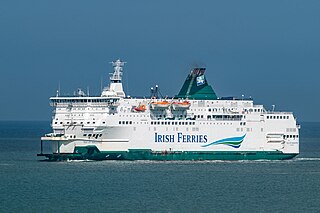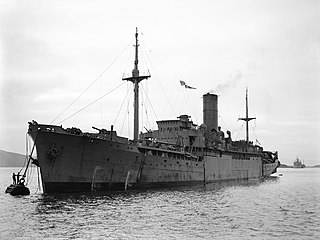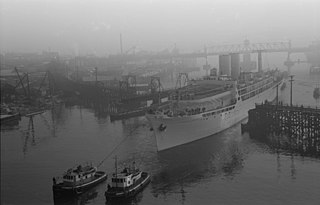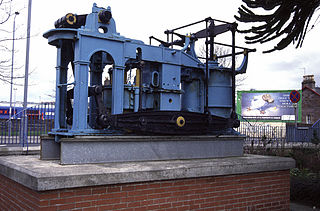Related Research Articles

The Fairfield Shipbuilding and Engineering Company, Limited was a Scottish shipbuilding company in the Govan area on the Clyde in Glasgow. Fairfields, as it is often known, was a major warship builder, turning out many vessels for the Royal Navy and other navies through the First World War and the Second World War. It also built many transatlantic liners, including record-breaking ships for the Cunard Line and Canadian Pacific, such as the Blue Riband-winning sisters RMS Campania and RMS Lucania. At the other end of the scale, Fairfields built fast cross-channel mail steamers and ferries for locations around the world. These included ships for the Bosporus crossing in Istanbul and some of the early ships used by Thomas Cook for developing tourism on the River Nile.

MS Isle of Innisfree is a passenger and car ferry to be operated by Irish Ferries between Dover and Calais. Originally built at Boelwerf as the Prins Filip originally sailing between Dover and Ostend, later between Ostend and Ramsgate, she has since 1997 operated for a wide variety of companies.

A & J Inglis, Ltd, was a shipbuilding firm founded by Anthony Inglis and his brother John, engineers and shipbuilders in Glasgow, Scotland in 1862. The firm built over 500 ships in a period of just over 100 years. Their Pointhouse Shipyard was at the confluence of the rivers Clyde and Kelvin. They constructed a wide range of ships, including Clyde steamers, paddle steamers and small ocean liners. In wartime, they built small warships, and in the period after World War II, they built a number of whalers.
Two ships of the Royal Navy have been named HMS Prince Albert, after Prince Albert, husband of Queen Victoria:
SS Montrose was a British merchant steamship that was built in 1897 and wrecked in 1914. She was built as a cargo liner for Elder, Dempster & Company. In 1903 the Canadian Pacific Railway bought her and had her converted into a passenger liner.

Regie voor Maritiem Transport (RMT) was the Belgian state-owned ferry service and operated ferries on the Ostend-Dover route under the name Oostende Lines. For the last few years until its demise in February 1997, the ferries from Ostend went to Ramsgate instead of Dover in partnership with Sally Line.

Invicta was a passenger ferry built in 1939 for the Southern Railway and requisitioned on completion by the Admiralty for use as a troopship, serving in the Second World War as HMS Invicta. She was returned to the Southern Railway in 1945 and passed to British Railways in 1948. With the introduction to TOPS in 1968, Invicta was one of 14 "locomotives" classified as Class 99. She was allocated TOPS Number 99 010. Invicta served on the Dover – Calais route from 1946 until 1972 when she was withdrawn from service and scrapped.

SS Robert Coryndon was a British twin-screw passenger and cargo ferry on Lake Albert in central Africa.

John Bowes, built on the River Tyne in England in 1852, was one of the first steam colliers. She traded for over 81 years before sinking in a storm off Spain.

SS Mona's Isle was a steam turbine passenger ship that was built in Scotland in 1905 as Onward, renamed Mona's Isle in 1920, and scrapped in Wales in 1948. She was designed as an English Channel ferry for the South Eastern and Chatham Railway (SE&CR), who operated her between Folkestone and Boulogne. In 1920 the Isle of Man Steam Packet Company (IoMSP) bought her and renamed her Mona's Isle. The IoMSP ran her mainly on summer services linking Douglas with Dublin and Belfast. She was the fourth IoMSP ship to be called Mona's Isle.
SS Abukir was a British coastal steamship that was launched in 1920 as SS Island Queen and renamed in 1934 as SS Kyle Queen. In 1935 she was renamed Abukir and registered in Egypt. In May 1940 she was torpedoed and sunk in the North Sea while evacuating UK and Belgian soldiers, airmen and civilians from Ostend on the last day of the Battle of Belgium.
Vortigern was a 4,797 GRT combined train and roll-on/roll-off ferry built by Swan Hunter in 1969 for the British Railways Board. She was sold to Greece in 1988 and served until 2004 under the names Milos Express, Express Milos and Nisos Lemnos. She was renamed Limon in 2004 and reflagged to Saint Vincent & the Grenadines. Limon was scrapped in 2005.

HMS Agamemnon was originally the Blue Funnel Line refrigerated cargo ship Agamemnon. She was built in 1929, traded between the UK and the Far East, and was scrapped in 1963. During the Second World War she was converted into an auxiliary minelayer in 1940, and then into an amenities ship in 1943.

HMS Menestheus was originally the Blue Funnel Line refrigerated cargo ship Menestheus. She was built in 1929, and traded between the UK and the Far East. She was an auxiliary minelayer from 1940 to 1943. When the Second World War in 1945, she was undergoing conversion into an amenities ship. She was scrapped in 1953 after being gutted by fire.
HMS Teviot Bank was a Bank Line steamship that was built in England in 1938 as the cargo ship Teviotbank. In the Second World War she was a Royal Navy auxiliary minelayer. By 1956 a Panamanian company had bought her and renamed her Nella. She was scrapped in Italy in 1971.
SS San Wilfrido was a 6,458 GRT steam-powered British tanker that was launched in February 1914 and sunk by a German mine less than six months later. Armstrong, Whitworth & Co Ltd built her on the River Tyne for the Eagle Oil Transport Co Ltd.

Messrs Robert Napier and Sons was a famous firm of Clyde shipbuilders and marine engineers at Govan, Glasgow founded by Robert Napier in 1826. It was moved to Govan for more space in 1841. His sons James and John were taken into partnership in 1853.
Water Witch was an early British wood-hulled paddle steamer, built in 1835 at Harwich, England for steam packet services from Dover to London and to Boulogne. A successful fast ship, she was later operated on services on the South Coast of England and in the Bristol Channel
References
- ↑ Gaines, W. Craig (2008). Encyclopedia of Civil War Shipwrecks (PDF). Louisiana State University Press. pp. 153–154. ISBN 978-0-8071-3274-6. Archived from the original (PDF) on 20 August 2018.
- ↑ "Prince Albert". Tyne Built Ships. Shipping & Shipbuilding Research Trust. Retrieved 24 May 2020.
- ↑ "Prince Albert". U-boat.net. Retrieved 24 May 2020.
- ↑ "Prince Albert". Tyne Built Ships. Shipping & Shipbuilding Research Trust. Retrieved 24 May 2020.
- ↑ Colledge, J J (1970). Ships of the Royal Navy: Vol 2. Newton Abbot: David & Charles. p. 287.
- ↑ Hasenson, Alec (1980). The History of Dover Harbour. London: Aurum Special Editions. p. 441. ISBN 0-906053-17-X.
- ↑ Hasenson, Alec (1980). The History of Dover Harbour. London: Aurum Special Editions. p. 461. ISBN 0-906053-17-X.
- ↑ "Prins Albert (7613882)" . Miramar Ship Index . Retrieved 2020-05-24.